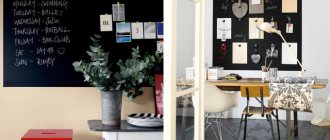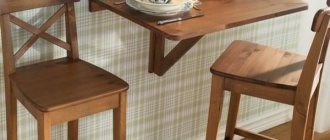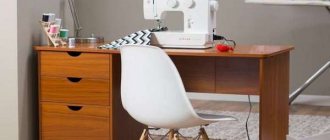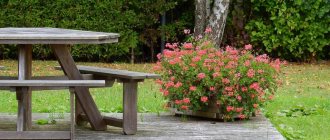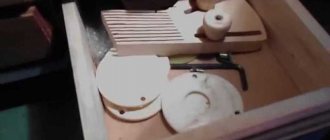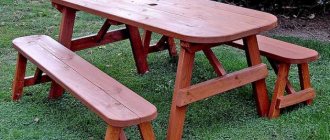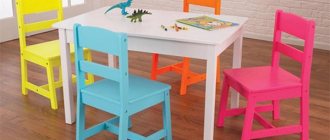For several years I dreamed of purchasing a light table for sand painting. The finished tables I saw were quite large in size and at a decent price. In addition, I didn’t want to overwhelm an already small apartment with oversized furniture.
In this article I will tell and show how I made a sand painting table with my own hands.
We take the LACK table from IKEA as a basis. It has a very small size: 55 cm x 55 cm and a height of 45 cm, there are many different colors, I chose green. At that time it cost 600 rubles.
Stage 1: Choosing the right acrylic (glass)
Ideally, I wanted to make the top of the table from one thick piece of acrylic with a step around the perimeter. However, acrylic must be milky (white) for uniform light dispersion, but it is quite expensive and generally difficult to find with a thickness of more than 5 mm. In addition, in order to make a step you need a router or something similar. My friends in the advertising workshop (where I bought glass) did not have such equipment. Instead, I ordered two sheets of acrylic from them. One transparent, 8 mm thick and one milky, 3 mm thick.
Glass sizes
- transparent acrylic 480mm x 480mm
- milky acrylic 550 mm x 550 mm (table size)
*in the photo the thick acrylic is also white, in fact it is transparent, just the protective film on it is white
What will you need to make a sand painting table?
The materials and tools needed to make a glowing table with your own hands are inexpensive.
Necessary materials
- Boards.
- A sheet of plywood 10 mm thick or furniture board.
- Glazing bead.
- Plexiglas.
- Ribbon with light bulbs.
- Fork
- Switch.
- Nails.
- Self-tapping screws.
- Water based varnish.
Required Tools
- Thicknessing machine for processing boards.
- Hacksaw for cutting boards and plywood.
- A hex key for driving screws or a hammer when using nails.
Step 2: Measure twice, cut once
- Carefully mark the top of the table. Check your markings, you can attach a sheet of thick acrylic to make sure that it will fit the cutout in the table. The sheet may not be cut out in exactly the right shape, so it is important to control this point.
- I recommend using only new blades for the mounting knife. To make an even cut, use a ruler as a guide. The ruler should not slide on the surface. Don't rush, because... It's very easy for the knife to jump off the cutting line.
- Remove the cut outer surface of the table. There we will see the honeycomb filling, it also needs to be completely removed.
- Make sure the cutout matches our acrylic.
What is the benefit of this activity
American cartoon director Carolyn Leaf presented an interesting idea to teachers and parents on how to organize children’s leisure time and develop multidirectional skills at the same time.
She created a sand video. The heroes came to life and acted on the luminous board. The artist painted them with her fingers using sand. The idea was picked up by other animators. The method of creating images and plots has been highly praised.
Gradually, drawing on a special board with sand came into the lives of ordinary people. Teachers began to practice such classes with children of different ages. The fascinating method of pedagogical work was studied from the point of view of psychology, physiology, and didactics. Teachers and preschool educators who practice innovation have noticed the following beneficial properties of such activities:
- Drawing with sand on glass is fun and interesting. 99% of children receive a charge of positive emotions during the lesson and entertainment.
- The method has no special rules. The baby can draw with his palm, one or more fingers, create any shapes and erase them quickly if something doesn’t work out.
- The absence of restrictions relieves emotional stress. Children are relaxed, moderately excited, and feel like the creators of a unique masterpiece.
- Motor skills develop. Kindergarteners are tired of plasticine and pencils; practicing finger dexterity with a light tablet and sand is no less useful. Speech develops simultaneously with motor skills.
- Graphomotor skills are improved. Schoolchildren develop the ability to follow a contour, hold a pen correctly, and observe the rhythm of movements.
- Suitable for any age. Nursery children, schoolchildren and adults enjoy drawing on the board. The magic of free-flowing animation leaves almost no one indifferent.
- Relief from stress. Working with sand is included in a course of psychotherapy for the treatment of neuroses, tics, and insomnia. Healthy children also calm down during classes, find peace of mind, and forget about troubles.
- A unique method helps to reveal creative potential and find yourself. The child shows imagination, shows hidden abilities, and is not afraid to evaluate the result.
If we consider the methodology from the point of view of organization and material costs, the following advantages are revealed:
- Consumables are cheap. It is not necessary to buy sand; use semolina or ground coffee.
- You can make a drawing tablet with your own hands. You will need a lamp, plexiglass, and a wooden box. The equipment takes up little space in the room and does not require special care.
- Any mother, father, or grandmother can teach a child to draw with sand. No special education or courses are required for classes.
Look at examples of work on the Internet and feel free to start creating.
Stage 3: Trim the corners
Each corner of our table is reinforced with chipboard blocks. They prevent us from installing thick acrylic. If you trim them, they will serve as a good support for the glass. It is necessary to trim to the thickness of the acrylic; this can be done with a regular mounting knife. Be careful, the main thing is not to cut yourself, if you cut off more than necessary, then it’s okay, with the help of scraps and PVA glue you can increase the required height.
Once we are sure that the thick sheet of acrylic fits perfectly into the bed prepared for it, we can begin painting the inside of the table. It may seem that this is not necessary, but it is not. The white color will help diffuse the light more evenly and increase the brightness of our light table.
Tips for beginners
You need to master an unconventional method for early development and entertainment of children after watching video lessons or recommendations from professionals. It is useful for beginners to know the following:
Place dots with the pads of different fingers. Remember how big they will be. This will help you not to make a mistake in choosing a finger when drawing eyes, fruits, or drawings on the body of animals. Before the lesson, try to pour an even layer of sand onto the glass. Use a sieve, funnels, and a little later your fists. Do not level the surface with your fingers. Fingerprints leave an unaesthetic mark. When kids learn to create simple images, try creating compositions from small parts using available tools. Professionals minimize the number of touches to sand. Movements should be sweeping and confident. Choose the best picture option for your level. Practice the technique of creating it to perfection. Rehearse the pattern several times. Before applying a stroke, consider its length and width. You can draw with sand on a light and sound board, a black polished table, or a kitchen baking sheet
The most important thing is the contrast between the surface and the bulk material.
Stage 4: Electrical
Here I had to turn to specialists (familiar advertisers).
- We took 5 meters of self-adhesive LED strip. This tape is powered by 12 volts, so a power supply is required in order for the sand painting table to be plugged into an outlet. The ribbon comes in a variety of colors, but the color chosen was cool white. Because it feels like the brightest.
- We wanted to make a switch, but we didn’t have one at hand
- A hole was drilled in the bottom of the table through which the plug was passed. At the opposite end of the plug, several clamps were tightened so that it did not fall into the hole.
How to make a table for sand animation with your own hands
Playful activities with the family are much more beneficial for young children than group classes in development centers. A backlit sand drawing tablet can be made at home from scrap materials. Dads will need:
- wooden box;
- a suitable piece of plexiglass;
- nails;
- electrical tape, scotch tape;
- wood paint;
- flashlight, lamp.
The manufacturing process will take no more than 1–2 hours, and children's joy will know no bounds. Make the table bigger so the whole family can use it at the same time. The instructions consist of the following steps:
- Clean the wooden box from excess, reduce the height of the sides. The average depth of space is 10–15 centimeters.
- Remove the bottom cover or make a slot to install the glass.
- Place the transparent part on the bottom half.
- Carefully secure the glass with strips from below.
- Make compartments on the sides for storing small items (sticks, sieves, rakes). To do this, nail the planks, retreating a couple of centimeters from the edge.
- Install the legs to the table. Choose the height according to the height and age of the youngest child.
- Place a bright flashlight or an electric lamp with good power under the table.
- The workspace for the little artist is ready.
Watch the video tutorial on how to make your own sand painting light table at home:
Sand compositions cannot be hung on the wall or left as souvenirs to show to friends and relatives. This is the only disadvantage of such creativity. But there is a way out. Record successful activities on camera, take pictures of the drawings. Make a video with music on the slides.
Memorizing numbers and letters
For young children who do not yet have literacy skills, letters and numbers are just meaningless symbols. What is the easiest way to understand and remember them? By activating associative, visual and sensory memory.
First we show the correct spelling of a letter or number. Then we take the child’s finger, and it exactly repeats everything we have done. You can blindfold him, and then he will draw a symbol, imagining its image.
Then we move to the level of association. Draw the letter c. We use imagination and try to create an environment in which the child will reveal his creative abilities and peculiarities of perception: how far can the letter O be drawn? To the sun, to the face, to part of the glasses, to the wheel
You can pay attention to what the child uses as an association - this word-symbol can then be used to remember the letter. As a rule, children first remember what a letter looks like, then the letter itself.
And for better memorization of numbers, you can come up with a travel fairy tale in which the numbers will turn into various objects of the surrounding world in order to help someone. For example, a one can become a pole for power lines if the wires break in the city, and an eight will delight children in hot countries by turning into a snowman. Entertain your child with a fairy tale on the sand, play yourself - this way you will not only relax together, but also spend time usefully.
8 games to develop fine motor skills
3 important principles for developing the creative potential of preschoolers
3 important questions about early development
Stage 5: Lighting Installation
Place the tape on the table, but do not secure/glue it. Make sure that the chosen laying pattern is ideal and the entire tape fits. It is better to start gluing from the end that is close to the connection cable, so that in the end you do not have to drill a new hole. The adhesive tape is quite strong, although I did add a few strips of double-sided tape on the folds and corners just to be safe.
We connect the tape to the power source. Tests show that everything works.
Stage 6: Installation of acrylic
Mark and drill holes in the first sheet of transparent acrylic. Next, we use this sheet as a template for drilling milky acrylic. The holes must be larger than the screws, otherwise the acrylic may crack when screwed.
The corners of milky acrylic can be rounded.
Select fasteners that are the right size for you. There are self-tapping screws of different colors and with different heads; I liked the shiny ones with a round head, which I chose.
Roll it all together and you're done! Try to keep the glass clean, otherwise dust and dirt on the inside of the acrylic or between two sheets will be very noticeable when you turn on the light table.
Light table with high sides
This type of light table is perfect for examining wet and unstable materials. You will need two boxes without lids.
Turn one box upside down. Cut a sheet of white paper to the appropriate size and cover the bottom of the box. Secure the paper with clear or paper tape, and place the second box on top, this time as it should be, without turning it over. Secure the boxes with clear tape. Place a string of light bulbs under the bottom drawer.
Back to contents
Game exercises
At home, in kindergarten, and in early development classes, children learn through play. This is the best way to teach the complex through the simple. A tabletop sandbox with high sides and play exercises for preschoolers will help you with this.
Training your fingers
Start your first acquaintance with animation not with theory, but with practice. Give the opportunity to touch, smell, and explore the material. Turn on the lighting in the sandbox. You can play soft music so that the kids are completely immersed in the process and understand that something unusual is about to happen.
Ask preschoolers to draw any object or figure on the glass with their finger. Let them tinker with the sand as much as they like.
At the same time, motor skills, imagination, and attention develop
Let's play hide and seek
You will need a rake, shovels and a thick layer of sand. Give students small toys (Kinder figurines). Ask to bury it unnoticed by others. Have a competition to see who can find a friend's toy faster with their eyes closed using their fingers.
What a surprise I have
The teacher hides various small objects (buttons, rags, pieces of paper, figurines, balls, coins) in the sandbox. The children's task is to find one object each with their hands, guess what it is by touch. In the process of understanding and feeling an object, you need to talk about your feelings and assumptions.
Treasure
The sand needs to be poured into a deep container or chest. Place pirate treasures inside: beads, coins, map, “gems”. You need to look for treasure with one finger. Attach a fascinating story to every discovery. Tell it yourself or come up with it with your children.
